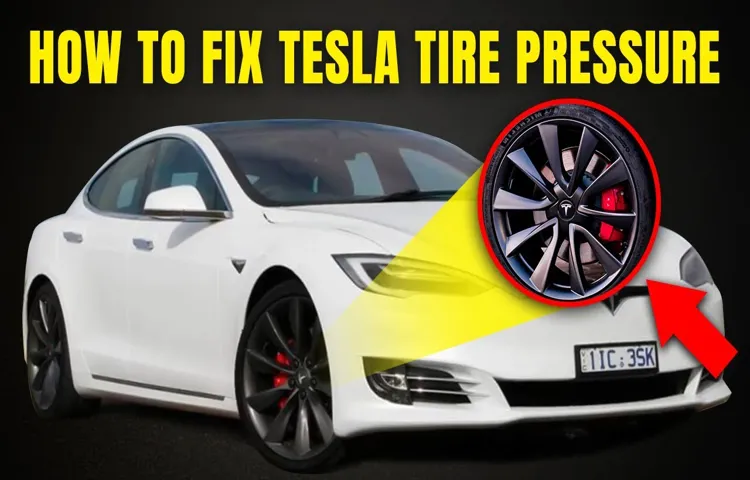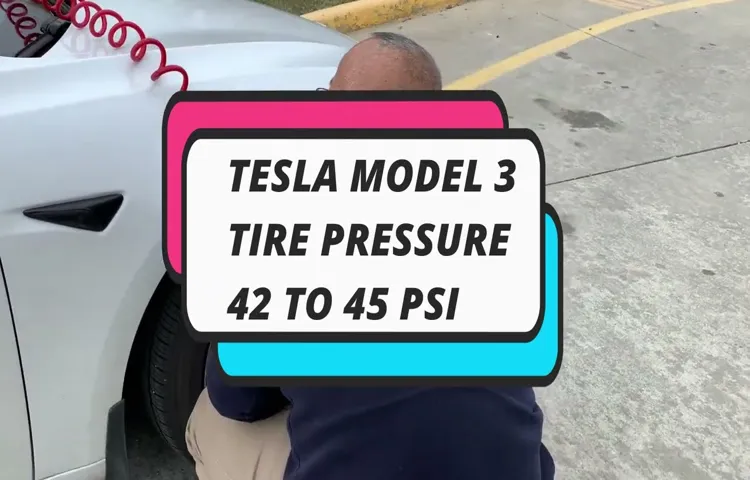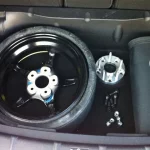Have you noticed that the recommended tire pressure for Tesla vehicles seems to be higher than what is recommended for other cars? You’re not alone. Many Tesla owners are perplexed by why their tire pressure is set so high. In fact, the recommended tire pressure for Teslas can be as high as 45 psi, while most other vehicles have a recommended pressure between 30-35 psi.
But why is this the case? It turns out that the high tire pressure in Teslas is due to a few factors. Firstly, Tesla vehicles are heavier than most other cars due to their battery packs. This means that they require more air pressure in the tires to maintain stability and performance on the road.
Secondly, the low rolling resistance tires that Teslas come equipped with require higher air pressure to maintain optimal performance. Finally, Tesla vehicles are designed to be energy-efficient, and high tire pressure helps to reduce rolling resistance, which in turn improves energy efficiency. Overall, while it may seem strange at first, the high tire pressure in Teslas is actually a design feature that helps to enhance their performance and energy efficiency.
So next time you’re checking your tire pressure, don’t be surprised if the recommended pressure seems a little higher than what you’re used to.
Table of Contents
Understanding Tire Pressure
One of the reasons why the tire pressure on a Tesla is higher than other cars is to reduce rolling resistance. Higher tire pressure means less contact with the road, which in turn reduces friction and improves the car’s overall range. However, it’s important to note that driving with the correct tire pressure is crucial for safety and performance.
Overinflation can cause the tires to wear out faster in the middle, while underinflation can lead to higher fuel consumption and poor handling. It’s recommended to follow the tire pressure guidelines in your Tesla manual and check the pressure regularly to ensure a smooth and safe driving experience. So, while it may seem odd at first, the higher tire pressure on a Tesla is actually a deliberate decision based on maximizing efficiency and performance.
Importance of Correct Tire Pressure
Tire pressure is one of the most crucial factors when it comes to car safety. Proper tire pressure helps ensure optimal tire performance, handling, and fuel efficiency, while reducing the risk of accidents. Understanding tire pressure is essential for any driver, because proper tire pressure ensures the car remains stable on the road.
But what exactly does tire pressure mean? In simple terms, it refers to the amount of air inside the tire, which is measured in PSI (pounds per square inch). A tire with too little air pressure can result in poor performance, potentially causing damage to the tire’s structure or even a blowout on the road. Likewise, a tire with too much air pressure may increase fuel consumption and cause tire wear and tear unevenly.
That’s why it’s important to check and adjust tire pressures at least once a month or before any long road trip. It’s an easy maintenance task that could save you some serious cash in the long run.

Tesla’s Recommended Tire Pressure
Tesla’s recommended tire pressure is a crucial aspect of car maintenance for drivers who aspire to maximize their electric vehicle’s drive range and obtain the best possible performance. As an EV, Tesla provides a tire pressure setting that enhances the vehicle’s fuel efficiency, handling, and overall safety. The recommended tire pressure for a Tesla varies by model and trim level, so it’s essential to review the owner’s manual or Tesla’s website for the precise setting.
However, as a general rule, Tesla’s recommend tire pressure falls within the range of 42-45 psi for the Model S, Model X, and Model It’s crucial not to overlook tire pressure as a contributing factor to the vehicle’s performance. Driving with the incorrect tire pressure can impact the tires’ lifespan, fuel economy, and handling.
Therefore, regular checks and maintenance of your EV’s tire pressure can go a long way in ensuring safety, efficiency, and longevity.
Reasons for High Tire Pressure in Tesla
If you’ve recently purchased a Tesla, you may have noticed that the recommended tire pressure is much higher than what you’re used to seeing on other vehicles. Typically, a tire pressure of around 30-35 PSI is common, but Teslas recommend anywhere between 39-50 PSI depending on the model. This is because Teslas have a heavier battery pack which makes the vehicle heavier overall.
The higher tire pressure helps with maximizing range and preserving the battery life by reducing the amount of energy needed to propel the vehicle forward. It also provides better handling and stability on the road, making the ride smoother and safer for the driver and passengers. However, it’s important to note that while high tire pressure may have its benefits, it’s crucial not to exceed the recommended PSI as it can lead to uneven wear on the tires and even risk a blowout while driving.
It’s always a good idea to regularly check and maintain the recommended tire pressure for optimal driving performance and safety.
Vehicle Weight and Efficiency
One of the main reasons for higher tire pressure in Tesla vehicles is to improve efficiency and range. A lighter vehicle generally consumes less energy, and higher tire pressure reduces rolling resistance and friction, requiring less energy from the battery. Additionally, tire pressure monitoring systems are standard in most Tesla models, alerting the driver when the pressure is too low, ultimately improving safety and reducing wear and tear on the tires.
The recommended tire pressure for Tesla vehicles is typically higher than other vehicles, with a range of 42 to 50 psi depending on the model. However, it’s important to note that overinflating tires can be dangerous and reduce stability and grip on the road. It’s crucial to follow the recommended tire pressure guidelines and regularly check and inflate the tires as needed for optimal efficiency and safety while driving a Tesla.
Improved Driving Performance
One of the main reasons why Tesla recommends high tire pressure in their vehicles is to improve driving performance. With high tire pressure, the car can easily maintain its balance, reduce rolling resistance, and make driving more efficient. This means that the vehicle will require less energy to move, resulting in better mileage and longer battery life.
Additionally, high tire pressure provides better handling and grip, reducing the risk of accidents or skidding on the road. While it may seem counterintuitive to increase tire pressure for better driving, it is an effective way to optimize your Tesla’s performance and make your daily commutes smoother and more enjoyable. Keep in mind that high tire pressure shouldn’t go overboard and should always be within Tesla’s recommended range for your specific vehicle model.
So, next time you’re checking your car’s tire pressure, make sure it’s at the optimum level for improved driving performance.
Safety Features
Safety Features Tesla is known for its innovative technology and high-performance vehicles, and one of its safety features is ensuring that the tire pressure is always kept at an optimal level. Maintaining a high tire pressure helps to enhance the car’s overall performance, stability, and handling on the road. When tires are underinflated, they tend to bulge out and become weaker, leading to higher rates of friction and reduced fuel efficiency.
On the other hand, when tires are overinflated, they become more rigid and lose the ability to handle much shock absorption, leading to discomfort while driving. Tesla vehicles come equipped with TPMS (Tire Pressure Monitoring System), which alerts drivers in real-time if tire pressure is too low or too high. Additionally, Tesla’s Model S and Model X offer tire pressure sensors that enable the driver to check the tire pressure without getting out of the car, making for a more convenient and safer experience.
Overall, ensuring the correct tire pressure is not only essential for a smoother and more comfortable ride, but it also contributes to maintaining the vehicle’s overall safety and efficiency on the road.
Common Misconceptions About Tire Pressure
Many people believe that Tesla’s recommended tire pressure is too high, which leads to misconceptions about tire pressure and its effects on a vehicle’s performance. However, Tesla’s high tire pressure recommendation is actually intentional and beneficial. A higher tire pressure allows for better handling and fuel efficiency, as well as prolonging the life of the tires themselves.
This is because a higher tire pressure decreases the contact area between the tire and the road surface, reducing rolling resistance and preventing excess wear on the tire’s shoulders. While it may seem counterintuitive to increase tire pressure for better performance, it is a proven and effective method for maximizing a vehicle’s capabilities. Therefore, it is important to follow Tesla’s recommended tire pressure for optimal performance, fuel efficiency, and safety on the road.
Tire Wear and Tear
One of the most common misconceptions about maintaining proper tire pressure is that you should always inflate your tires to the maximum pressure listed on the sidewall. However, this is not the case. In fact, overinflating your tires can be just as damaging as underinflating them.
The correct tire pressure for your vehicle can be found in your owner’s manual or on a sticker located on the inside of the driver’s side door. It’s important to keep your tires properly inflated to ensure even wear and maximum lifespan. Underinflated tires can lead to increased rolling resistance, which can cause uneven tread wear and negatively impact fuel efficiency.
On the other hand, overinflated tires can cause the center tread to wear more quickly and reduce handling and braking capabilities. By maintaining the correct tire pressure, you can improve your vehicle’s performance and safety while also prolonging the life of your tires.
Fuel Efficiency
Fuel Efficiency, Tire Pressure One of the most common misconceptions about fuel efficiency and tire pressure is that inflating your tires to the maximum pressure listed on the tire itself will improve your gas mileage. However, this is not the case. The correct tire pressure for your vehicle can be found in your owner’s manual or on the sticker inside the driver’s side door frame.
Inflating your tires too much can actually lead to reduced fuel efficiency, as well as decreased handling and control while driving. On the other hand, driving with underinflated tires can also reduce fuel efficiency and cause your tires to wear out more quickly. It’s essential to keep your tire pressure at the recommended level to ensure the best possible gas mileage and overall performance of your vehicle.
Checking your tire pressure regularly, especially before taking a long trip, is a small but important step you can take to improve your vehicle’s fuel efficiency and save money at the pump.
Final Thoughts
In conclusion, the reason why Tesla tire pressure is typically higher than other vehicles is due to its efficiency and performance. Tesla cars are designed to be high-powered electric vehicles that can achieve impressive speeds and acceleration. Therefore, the tires must be inflated to a higher pressure to maintain stability and control at these high speeds.
Additionally, keeping the tires at a higher pressure can also improve the vehicle’s range as it reduces the friction between the tires and the road. However, it’s important to note that each Tesla model has its unique recommended tire pressure, which owners should follow to ensure optimal driving performance. Overall, maintaining proper tire pressure is crucial for safety and vehicle performance, so it’s always recommended to check your tire pressure regularly and make the necessary adjustments.
Conclusion
In conclusion, the reason Tesla recommends such high tire pressure is because they want you to feel like you’re driving on air, quite literally. But in all seriousness, with higher tire pressure comes better handling, improved fuel efficiency, and reduced wear and tear on the tires. So while it may seem unconventional, it’s just another genius move by Tesla to provide their drivers with an optimized driving experience.
“
FAQs
What is the recommended tire pressure for Tesla vehicles?
The recommended tire pressure for Tesla vehicles is between 42 to 45 psi.
Why is Tesla’s tire pressure higher than other cars?
Tesla’s tire pressure is higher than other cars because it helps improve the car’s aerodynamics, which ultimately improves its overall efficiency.
What happens if the tire pressure is too high in a Tesla?
If the tire pressure is too high in a Tesla, it can cause a harsh ride, reduced traction, and faster tire wear in the center of the tire.
Can I adjust the tire pressure to lower than the recommended psi?
It is not recommended to adjust the tire pressure to lower than the recommended psi as it can cause handling problems, reduced range, and even damage to the tire.
What are the benefits of maintaining the recommended tire pressure in a Tesla?
Maintaining the recommended tire pressure in a Tesla can improve the car’s handling, increase its range, and prevent uneven tire wear.
How often should I check my Tesla’s tire pressure?
It is recommended to check your Tesla’s tire pressure at least once a month or before embarking on a long trip.
Can I use a tire pressure monitoring system (TPMS) to check my Tesla’s tire pressure?
Yes, Tesla vehicles come equipped with a built-in TPMS that constantly monitors the tire pressure and alerts the driver if any tire pressure is low.



